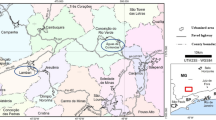Abstract
There are few data reported on radionuclide contamination in Antarctica. The aim of this paper is to report 137Cs, 90Sr and 238,239+240Pu and 40K activity concentrations measured in biological samples collected from King George Island (Southern Shetlands, Antarctica), mostly during 2001–2002. The samples included: bones, eggshells and feathers of penguin Pygoscelis papua, bones and feathers of petrel Daption capense, bones and fur of seal Mirounga leonina, algae Himantothallus grandifolius, Desmarestia anceps and Cystosphaera jacquinotii, fish Notothenia corriceps, sea invertebrates Amphipoda, shells of limpet Nacella concina, lichen Usnea aurantiaco-atra, vascular plants Deschampsia antarctica and Colobanthus quitensis, fungi Omphalina pyxidata, moss Sanionia uncinata and soil. The results show a large variation in some activity concentrations. Samples from the marine environment had lower contamination levels than those from terrestrial ecosystems. The highest activity concentrations for all radionuclides were found in lichen and, to a lesser extent, in mosses, probably because lichens take up atmospheric pollutants and retain them. The only significant correlation (except for that expected between 238Pu and 239+240Pu) was noted for moss and lichen samples between plutonium and 90Sr. A tendency to a slow decrease with time seems to be occurring. Analyses of the activity ratios show varying fractionation between various radionuclides in different organisms. Algae were relatively more highly contaminated with plutonium and radiostrontium, and depleted with radiocesium. Feathers had the lowest plutonium concentrations. Radiostrontium and, to a lesser extent, Pu accumulated in bones. The present low intensity of fallout in Antarctic has a lower 238Pu/239+240Pu activity ratio than that expected for global fallout.



Similar content being viewed by others
References
Baeza A, Del Rio M, Paniagua JM, Navarro E, Rodriguez MJ, Sanchez F (1994) Radioactive concentrations of the Livingstone Island soils (Antarctica). Dosimetry considerations. Appl Radiat Isot 46(6):675–681
Desideri D, Giuliani S, Testa C, Triulzi C (2002) 90Sr, 137Cs, 238Pu, 239+240Pu and 241Am levels in terrestrial and marine ecosystems around Italian base in Antarctica. J Radioanal Nucl Chem 258(2):221–225
Gaca P (2004) Nagromadzenie i ocena skażenia środowiska przyrodniczego Polski izotopem 90Sr. Ph.D. Thesis, Department of Chemistry, Gdańsk University
Giuliani S, Triulzi C, Vaghi M (2003) Anthropogenic radionuclides in plants, animals and the environments in Antarctica. Morskij Ekologichnij Zhurnal 2(2):5–15
Godoy JM, Schuch LA, Nordemann DJR, Reis VRG, Ramalho M, Recio JC, Brito RRA, Olech MA (1998) 137Cs, 226,228Ra, 210Pb and 40K concentrations in Antarctic soil, sediment and selected moss and lichen samples. J Environ Radioact 41(1):33–45
Gulin SB, Stokozov NA (2005) 137Cs concentrations in Atlantic and western Antarctic surface waters: results of the 7th Ukrainian Antarctic Expedition, 2002. J Environ Radioact 83:1–7
IAEA (2002) Analytical quality control services—reference materials catalogue 2002–2003. IAEA, Vienna
Jia G, Triulzi C, Nonnis Marzano F, Belli M, Vaghi M (2000) The fate of plutonium, 241Am, 90Sr and 137Cs in the Antarctic ecosystems. Antarct Sci 12(2):141–148
LaRosa JJ, Cooper E, Ghods-Esphahani A, Jansta V, Makarewicz M, Shawky S, Vajda N (1992) Radiochemical methods used by the IAEA’s laboratories at Seibersdorf for the determination of 90Sr, 144Ce and Pu radionuclides in the environment samples collected for the international Chernobyl project. J Environ Radioact 17:183–209
Marzano FN, Fiori F, Jia G, Chiantore M (2000) Anthropogenic radionuclides bioaccumulation in Antarctic marine fauna and its ecological relevance. Polar Biol 23(11):753–758
Mietelski JW, Jasińska M, Kozak K, Ochab E (1996) The method of measurements used in the investigation of radioactive contamination of forests in Poland. Appl Radiat Isot 47(9/10):1089–1095
Mietelski JW, Gaca P, Olech MA (2000) Radioactive contamination of lichens and mosses collected in South Shetlands and Antarctic Peninsula. J Radioanal Nucl Chem 245(3):527–535
Mietelski JW, Hajduk Z, Hajduk L, Jurkowski J (2004) Some background effects observed with a low-level gamma spectrometer with muon veto detector. In: Book of extended synopsis, international conference on isotopes in environmental studies, aquatic forum 2004, Monaco, 25–29 October 2004, IAEA-CN-118, pp 292–293
Navas A, Soto J, Lopez-Martinez J (2005) Radionuclides in soils of Byers Peninsula, South Shetland Islands, Western Antarctica. Appl Radia Isot 62:809–816
Roos P, Holm E, Persson RBR, Aarkrog A, Nielsen SP (1994) Deposition of 210Pb, 137Cs, 239+240Pu, 238Pu and 241Am in the Antarctic Peninsula Area. J Environ Radioact 24:235–251
Schuch LA, Saiki M, Vasconcellos MBA, Godoy JM, Nordemann DJR (1994) Determinacao de Radionuclideos Naturais e Artificias e Otros Elementos Tracos em Amostras Ambientais da Antarctica. Congresso Geral de Energia Nuclear 5. CGEN. Rio de Janeiro, Brasil
Schuller P, Bunzl K, Voigt G, Handl J, Ellies A, Castillo A (2002) Fallout radiocesium in an Antarctic region: deposition history, activity density and vertical transport in soils. Radiat Environ Biophys 41:295–302
Schuller P, Bunzl K, Voigt G, Ellies A, Castillo A (2004) Global fallout 137Cs accumulation and vertical migration in selected soils from South Patagonia. J Environ Radioact 71:43–60
Sill CW (1987) Precipitation of actinides as fluorides or hydroxides for high resolution alpha Spectrometry. Nucl Chem Waste Manag 7:201–215
Tubertini O, Giovanna Bettoli M, Cantelli L, Tositti L, Valcher S, Triulzi C, Marzano FN, Mori A, Vaghi M, Sbrignadello, Degetto S, Faggin M (1995) Italian Antarctic Research Program: environmental radioactivity survey around the Italian Base (1987–1991) Terra Nova Bay—Ross Sea Region. J Environ Radioact 1:35–41
UNSCEAR (1982) Ionizing radiation sources and biological effects. Raport to the general assembly with annexes. United Nations Publications, New York
Vajda N, Ghods-Esphahani A, Cooper E, Danesi PR (1992) Determination of radiostrontium in soil samples using a crown ether. J Radioanal Nucl Chem 162(2):307–323
Acknowledgments
Project was partially supported by Polish Ministry of Sciences and Higher Education (Grant 1290/P01/2007/32).
Author information
Authors and Affiliations
Corresponding author
Rights and permissions
About this article
Cite this article
Mietelski, J.W., Olech, M.A., Sobiech-Matura, K. et al. 137Cs, 40K, 238Pu, 239+240Pu and 90Sr in biological samples from King George Island (Southern Shetlands) in Antarctica. Polar Biol 31, 1081–1089 (2008). https://doi.org/10.1007/s00300-008-0449-5
Received:
Revised:
Accepted:
Published:
Issue Date:
DOI: https://doi.org/10.1007/s00300-008-0449-5




